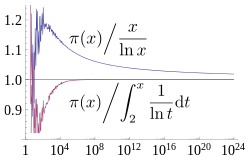پرونده:Prime number theorem ratio convergence.svg

حجم پیشنمایش PNG این SVG file:۲۵۰ × ۱۶۰ پیکسل کیفیتهای دیگر: ۳۲۰ × ۲۰۵ پیکسل | ۶۴۰ × ۴۱۰ پیکسل | ۱٬۰۲۴ × ۶۵۵ پیکسل | ۱٬۲۸۰ × ۸۱۹ پیکسل | ۲٬۵۶۰ × ۱٬۶۳۸ پیکسل.
پروندهٔ اصلی (پروندهٔ اسویجی، با ابعاد ۲۵۰ × ۱۶۰ پیکسل، اندازهٔ پرونده: ۸۷ کیلوبایت)
تاریخچهٔ پرونده
روی تاریخ/زمانها کلیک کنید تا نسخهٔ مربوط به آن هنگام را ببینید.
| تاریخ/زمان | بندانگشتی | ابعاد | کاربر | توضیح | |
|---|---|---|---|---|---|
| کنونی | ۲۱ مارس ۲۰۱۳، ساعت ۱۳:۰۷ |  | ۲۵۰ در ۱۶۰ (۸۷ کیلوبایت) | Dcoetzee | Change n to x to match article |
| ۲۱ مارس ۲۰۱۳، ساعت ۱۲:۳۰ |  | ۲۵۰ در ۱۶۰ (۸۶ کیلوبایت) | Dcoetzee | Convert formula from graphics to pure SVG using http://www.tlhiv.org/ltxpreview/ | |
| ۲۱ مارس ۲۰۱۳، ساعت ۱۲:۲۳ |  | ۲۵۰ در ۱۶۰ (۱۳۰ کیلوبایت) | Dcoetzee | {{Information |Description ={{en|1=A plot showing how two estimates described by the prime number theorem, <math>\frac{n}{\ln n}</math> and <math>\int_2^n \frac{1}{\ln t} \mathrm{d}t = Li(n) = li(n) - li(2)</math> converge asymptotically towards <ma... |
کاربرد پرونده
صفحههای زیر از این تصویر استفاده میکنند:
کاربرد سراسری پرونده
ویکیهای دیگر زیر از این پرونده استفاده میکنند:
- کاربرد در ar.wikipedia.org
- کاربرد در bn.wikipedia.org
- کاربرد در ca.wikipedia.org
- کاربرد در el.wikipedia.org
- کاربرد در en.wikipedia.org
- کاربرد در he.wikipedia.org
- کاربرد در hu.wikipedia.org
- کاربرد در hy.wikipedia.org
- کاربرد در id.wikipedia.org
- کاربرد در ja.wikipedia.org
- کاربرد در no.wikipedia.org
- کاربرد در pl.wikipedia.org
- کاربرد در sl.wikipedia.org
- کاربرد در sr.wikipedia.org
- کاربرد در sv.wikipedia.org
- کاربرد در ta.wikipedia.org
- کاربرد در vi.wikipedia.org




